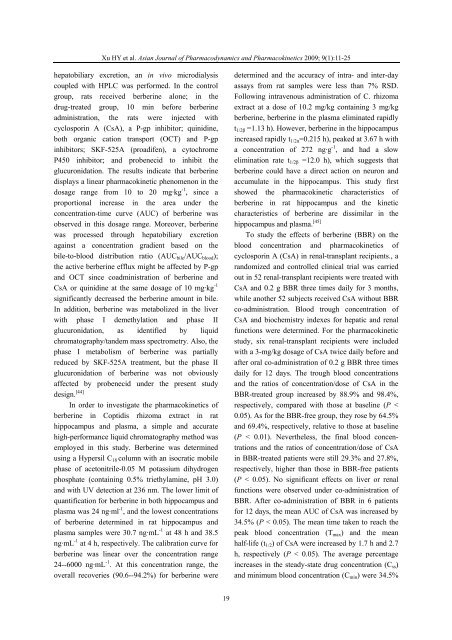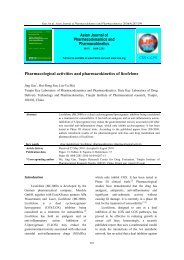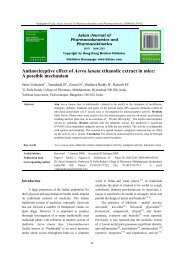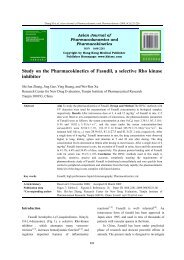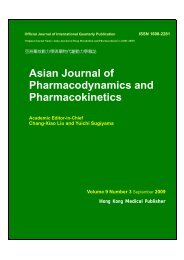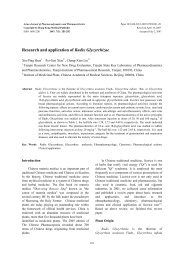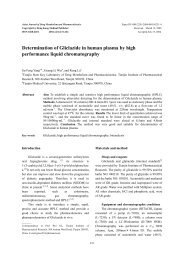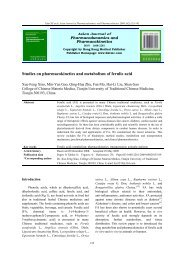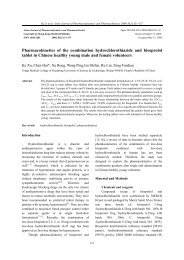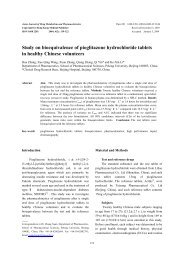Asian Journal of Pharmacodynamics and Pharmacokinetics
Asian Journal of Pharmacodynamics and Pharmacokinetics
Asian Journal of Pharmacodynamics and Pharmacokinetics
You also want an ePaper? Increase the reach of your titles
YUMPU automatically turns print PDFs into web optimized ePapers that Google loves.
Xu HY et al. <strong>Asian</strong> <strong>Journal</strong> <strong>of</strong> <strong>Pharmacodynamics</strong> <strong>and</strong> <strong>Pharmacokinetics</strong> 2009; 9(1):11-25<br />
hepatobiliary excretion, an in vivo microdialysis<br />
coupled with HPLC was performed. In the control<br />
group, rats received berberine alone; in the<br />
drug-treated group, 10 min before berberine<br />
administration, the rats were injected with<br />
cyclosporin A (CsA), a P-gp inhibitor; quinidine,<br />
both organic cation transport (OCT) <strong>and</strong> P-gp<br />
inhibitors; SKF-525A (proadifen), a cytochrome<br />
P450 inhibitor; <strong>and</strong> probenecid to inhibit the<br />
glucuronidation. The results indicate that berberine<br />
displays a linear pharmacokinetic phenomenon in the<br />
dosage range from 10 to 20 mg·kg -1 , since a<br />
proportional increase in the area under the<br />
concentration-time curve (AUC) <strong>of</strong> berberine was<br />
observed in this dosage range. Moreover, berberine<br />
was processed through hepatobiliary excretion<br />
against a concentration gradient based on the<br />
bile-to-blood distribution ratio (AUC bile /AUC blood );<br />
the active berberine efflux might be affected by P-gp<br />
<strong>and</strong> OCT since coadministration <strong>of</strong> berberine <strong>and</strong><br />
CsA or quinidine at the same dosage <strong>of</strong> 10 mg·kg -1<br />
significantly decreased the berberine amount in bile.<br />
In addition, berberine was metabolized in the liver<br />
with phase I demethylation <strong>and</strong> phase II<br />
glucuronidation, as identified by liquid<br />
chromatography/t<strong>and</strong>em mass spectrometry. Also, the<br />
phase I metabolism <strong>of</strong> berberine was partially<br />
reduced by SKF-525A treatment, but the phase II<br />
glucuronidation <strong>of</strong> berberine was not obviously<br />
affected by probenecid under the present study<br />
design. [44]<br />
In order to investigate the pharmacokinetics <strong>of</strong><br />
berberine in Coptidis rhizoma extract in rat<br />
hippocampus <strong>and</strong> plasma, a simple <strong>and</strong> accurate<br />
high-performance liquid chromatography method was<br />
employed in this study. Berberine was determined<br />
using a Hypersil C 18 column with an isocratic mobile<br />
phase <strong>of</strong> acetonitrile-0.05 M potassium dihydrogen<br />
phosphate (containing 0.5% triethylamine, pH 3.0)<br />
<strong>and</strong> with UV detection at 236 nm. The lower limit <strong>of</strong><br />
quantification for berberine in both hippocampus <strong>and</strong><br />
plasma was 24 ng·ml -1 , <strong>and</strong> the lowest concentrations<br />
<strong>of</strong> berberine determined in rat hippocampus <strong>and</strong><br />
plasma samples were 30.7 ng·mL -1 at 48 h <strong>and</strong> 38.5<br />
ng·mL -1 at 4 h, respectively. The calibration curve for<br />
berberine was linear over the concentration range<br />
24--6000 ng·mL -1 . At this concentration range, the<br />
overall recoveries (90.6--94.2%) for berberine were<br />
determined <strong>and</strong> the accuracy <strong>of</strong> intra- <strong>and</strong> inter-day<br />
assays from rat samples were less than 7% RSD.<br />
Following intravenous administration <strong>of</strong> C. rhizoma<br />
extract at a dose <strong>of</strong> 10.2 mg/kg containing 3 mg/kg<br />
berberine, berberine in the plasma eliminated rapidly<br />
t 1/2β =1.13 h). However, berberine in the hippocampus<br />
increased rapidly t 1/2α =0.215 h), peaked at 3.67 h with<br />
a concentration <strong>of</strong> 272 ng·g -1 , <strong>and</strong> had a slow<br />
elimination rate t 1/2β =12.0 h), which suggests that<br />
berberine could have a direct action on neuron <strong>and</strong><br />
accumulate in the hippocampus. This study first<br />
showed the pharmacokinetic characteristics <strong>of</strong><br />
berberine in rat hippocampus <strong>and</strong> the kinetic<br />
characteristics <strong>of</strong> berberine are dissimilar in the<br />
hippocampus <strong>and</strong> plasma. [45] <br />
To study the effects <strong>of</strong> berberine (BBR) on the<br />
blood concentration <strong>and</strong> pharmacokinetics <strong>of</strong><br />
cyclosporin A (CsA) in renal-transplant recipients., a<br />
r<strong>and</strong>omized <strong>and</strong> controlled clinical trial was carried<br />
out in 52 renal-transplant recipients were treated with<br />
CsA <strong>and</strong> 0.2 g BBR three times daily for 3 months,<br />
while another 52 subjects received CsA without BBR<br />
co-administration. Blood trough concentration <strong>of</strong><br />
CsA <strong>and</strong> biochemistry indexes for hepatic <strong>and</strong> renal<br />
functions were determined. For the pharmacokinetic<br />
study, six renal-transplant recipients were included<br />
with a 3-mg/kg dosage <strong>of</strong> CsA twice daily before <strong>and</strong><br />
after oral co-administration <strong>of</strong> 0.2 g BBR three times<br />
daily for 12 days. The trough blood concentrations<br />
<strong>and</strong> the ratios <strong>of</strong> concentration/dose <strong>of</strong> CsA in the<br />
BBR-treated group increased by 88.9% <strong>and</strong> 98.4%,<br />
respectively, compared with those at baseline (P <<br />
0.05). As for the BBR-free group, they rose by 64.5%<br />
<strong>and</strong> 69.4%, respectively, relative to those at baseline<br />
(P < 0.01). Nevertheless, the final blood concentrations<br />
<strong>and</strong> the ratios <strong>of</strong> concentration/dose <strong>of</strong> CsA<br />
in BBR-treated patients were still 29.3% <strong>and</strong> 27.8%,<br />
respectively, higher than those in BBR-free patients<br />
(P < 0.05). No significant effects on liver or renal<br />
functions were observed under co-administration <strong>of</strong><br />
BBR. After co-administration <strong>of</strong> BBR in 6 patients<br />
for 12 days, the mean AUC <strong>of</strong> CsA was increased by<br />
34.5% (P < 0.05). The mean time taken to reach the<br />
peak blood concentration (T max ) <strong>and</strong> the mean<br />
half-life (t 1/2 ) <strong>of</strong> CsA were increased by 1.7 h <strong>and</strong> 2.7<br />
h, respectively (P < 0.05). The average percentage<br />
increases in the steady-state drug concentration (C ss )<br />
<strong>and</strong> minimum blood concentration (C min ) were 34.5%<br />
19


